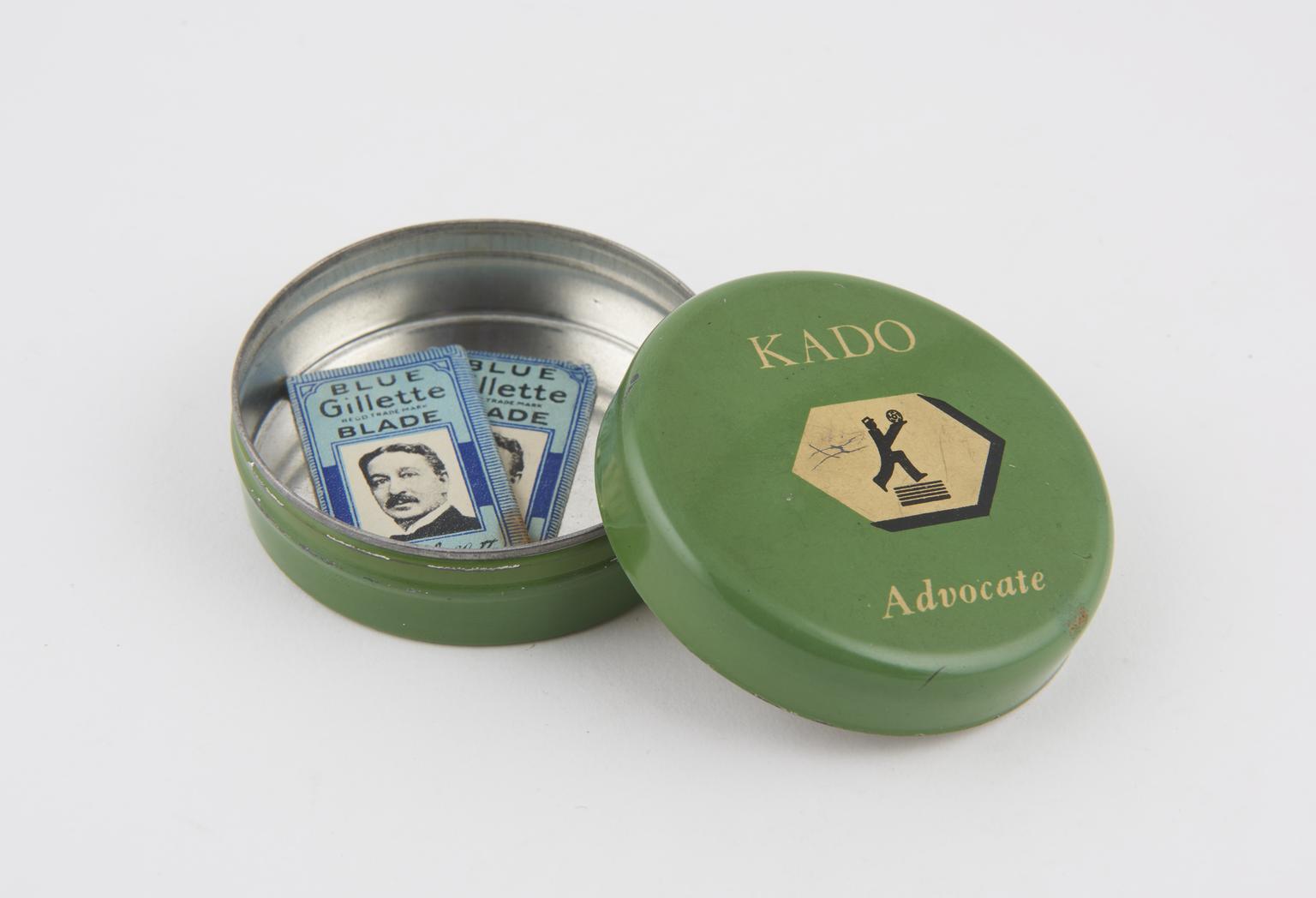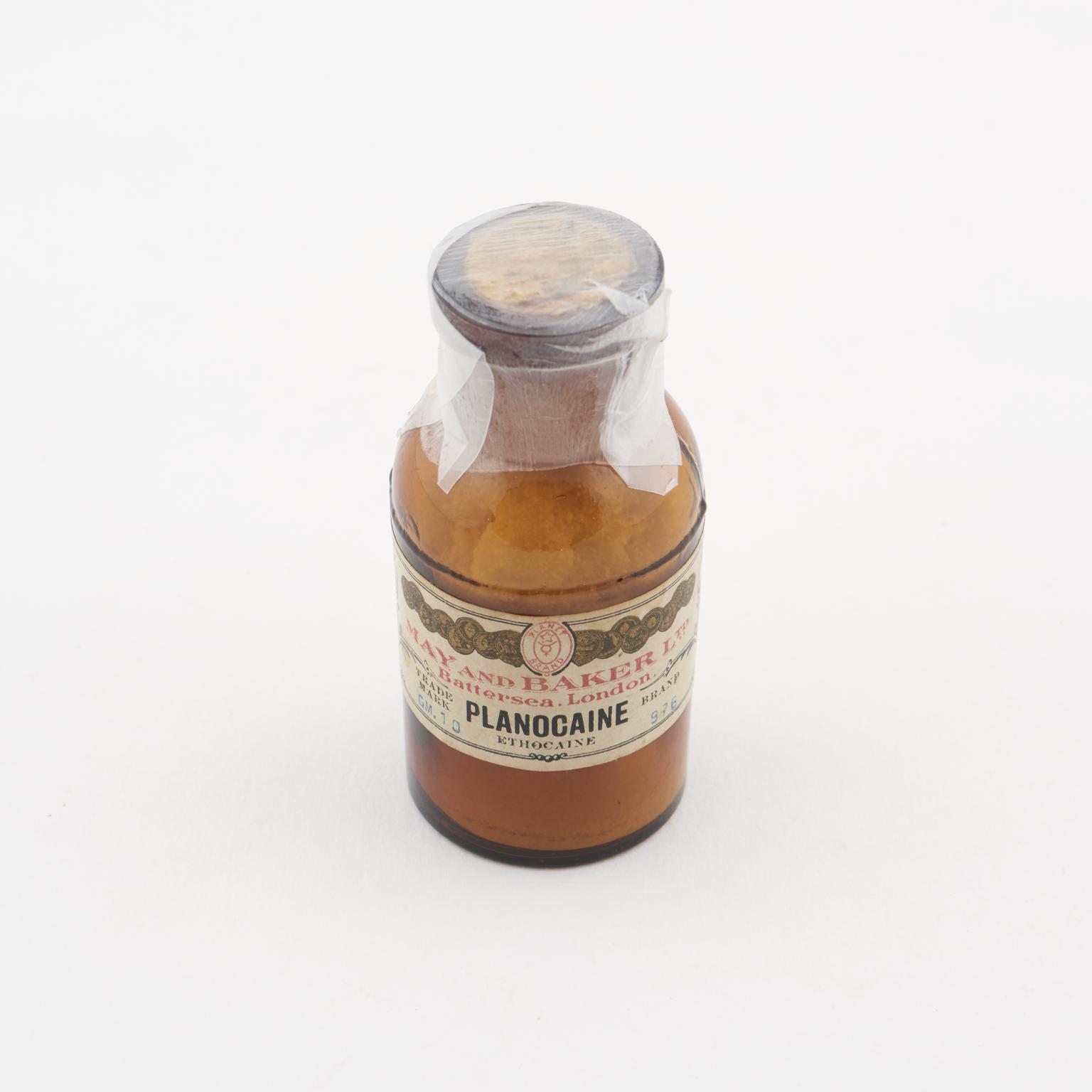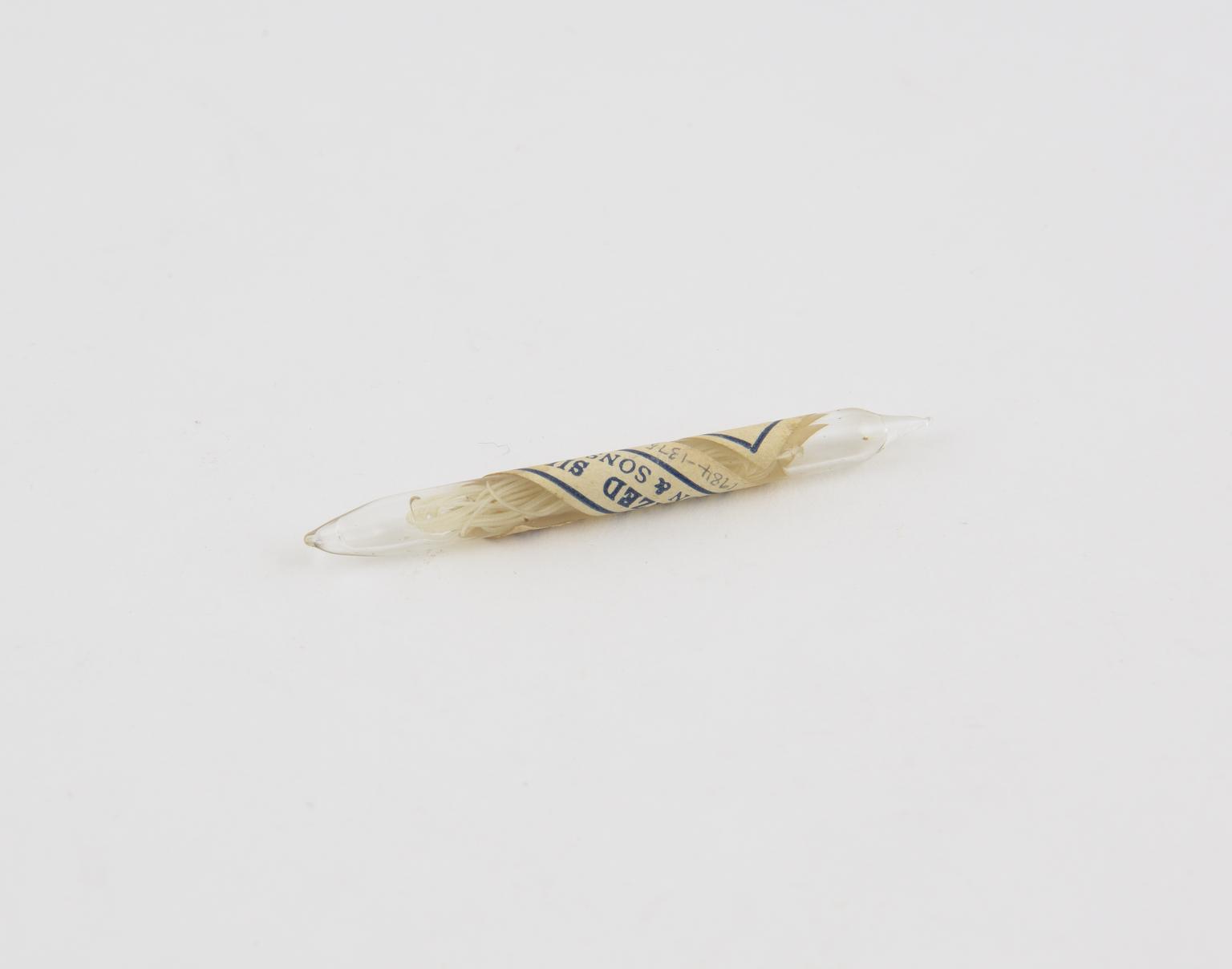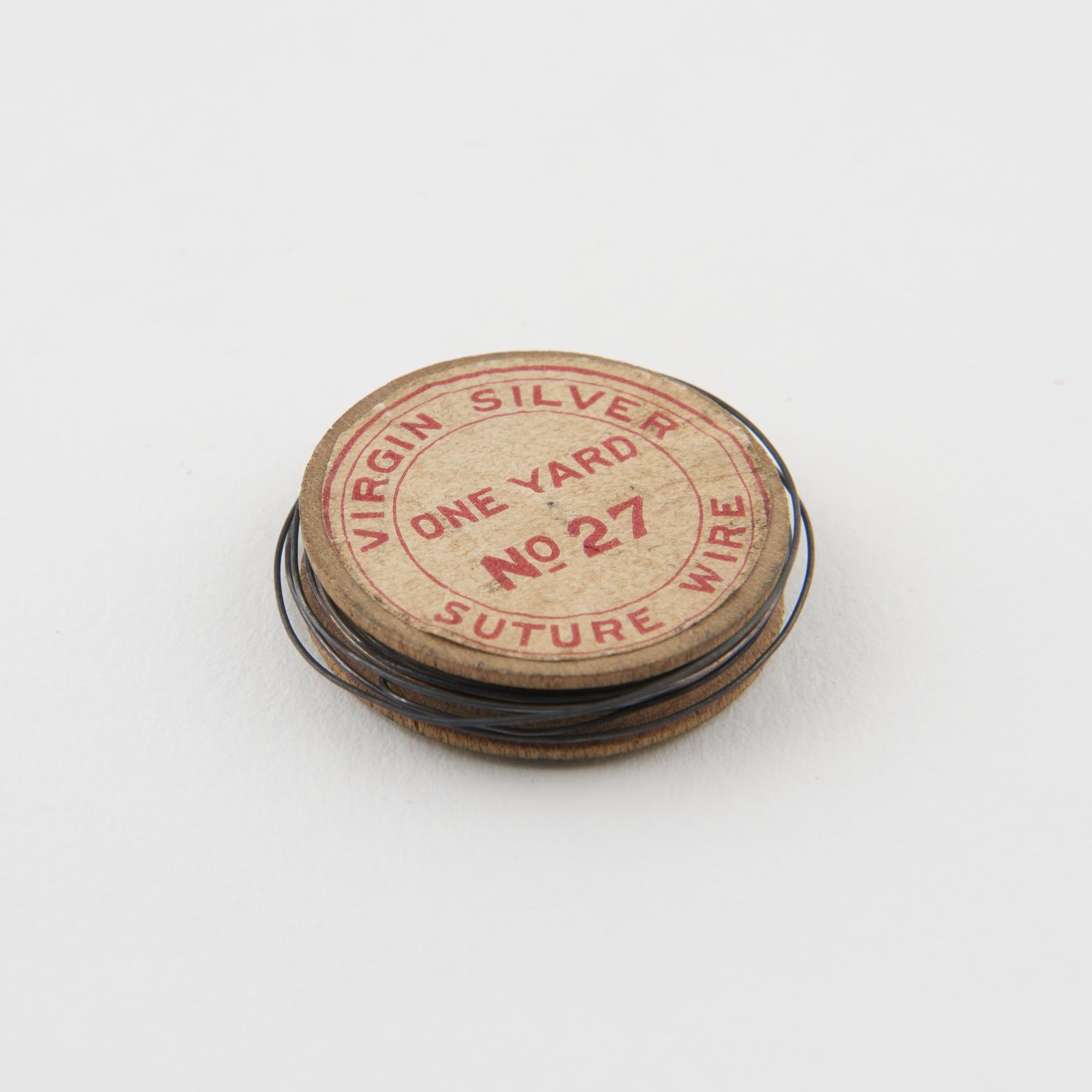Empty bottle used for laxative
Empty bottle used for laxative, white glass, English (?), 1920-1960

Collection of proprietary medicines, 1920-1960
Empty bottle used for laxative, white glass, English (?), 1920-1960
Glass drop bottle with glass stopper, empty, inscribed TK, English (?), 1900-1940
Glass drop bottle and stopper, empty, English (?), 1920-1940
2 glass bottle with glass stoppers, English (?), 1900-1930
Graduated drop bottle glass, English (?), 1900-1940
Empty bottle, glass with metal screw top, used for prepared digitalis tablets by Philip Harris Ltd., Birmingham, English, 1960-1964
Empty bottle, glass with cork stopper, used for "Tabloid" brand compressed sugar-coated laxative vegetable pills, prepared by Burroughs Wellcome and Co., London, 1934-1960
3 glass phials with plastic screw caps, empty, used for homoeopathic remedies prepared by A. Nelson and Co. Ltd., London, 1940-1965
2 glass bottle with cork stoppers, empty, originaly used for homoeopathic remedies prepared by A. Nelson and Co. Ltd., London, 1900-1940
Glass bottle with cork stopper containing psorinum pillules, homoeopathic, prepared by A. Nelson and Co. Ltd., London, 1900-1940
Glass bottle with plastic screw top used for Phenobarbitone tablets with trace contents remaining. 155 mm x 61 mm x 36 mm, 200 g. Prepared by Philip Harris Ltd., Birmingham, 1960-1962.
Glass bottle with plastic screw cap, empty, used for thyroid tablets prepared by Philip Harris Ltd., Birmingham, 1960-1961
Glass poison bottle with glass stopper, empty, used for Duncan's pure chloroform prepared by Duncan, Flockhart and Co., Edinburgh and London, 1920-1950
Glass bottle with plastic screw top, empty, used for panadol tablets prepared by R. E. Cheney Ltd, Lutterworth, 1967-1970
Glass poison bottle, empty, used for formalin prepared by Henry Davis (Newbury) Ltd., English, 1930-1960
Glass bottle with metal screw cap used for tablets of ipecacuanha and opium powder, now empty. 79 mm x 37 mm x 37 mm, 66 g. Handwritten note on label reads, 'TABLETS./ PULV. IPECAC et OPII 5 grains/...' Prepared by William Morrell, Kew, Surrey, 1910-1930.
Glass bottle with glass stopper and metal case, used for chloroform, by Zeno and Co., London, 1920-1940
2 glass bottle with plastic screw tops, empty, used for "Revonal" tablets prepared by E. Merck Ltd., Wokingham, 1940-1965
Empty tin used for Meggeson Dyspepsia Tablets, prepared by Meggeson and Co. Ltd., London, 1940-1970

2 Blue Gillette razor blades in tin, made by Gillette, English, 1940-1970
Absorbent ribbon gauze dressing in special dispersing bottle, prepared by J.E. Macfarlane and Co., Edinburgh and London, 1901-1930
Spirit burner, glass with metal wick dispenser and wick, likely British, 1901-1970
Circular china pillbox, empty, used for wind pills, prepared in London, 1870-1920
Empty glass bottle with glass stopper, used for solution of adrenaline hydrochloride, prepared by Boots, Nottingham, 1890-1930
Empty glass jar, used for boric acid crystals, prepared by Boots Cash Chemists (Southern) Ltd., 1901-1930
Glass bottle with metal screw cap, used for sterilised sulphanilamide, prepared by Burroughs Wellcome and Co., London, 1925-1935
Empty bottle used for xylol, glass with glass stopper, by Duncan, Flockhart and Co., Edinburgh and London, 1901-1930
Bottle of "Tabloid" brand quinine bisulphate tablets, prepared by Burroughs Wellcome and Co., London, supplied by Benson and Co., London, 1930-1960
Glass bottle for phenobarbitone tablets with trace remaining and a black bakelite lid. 57mm x 29 mm x 21 mm, 30g. Printed label reads, 'SELFRIDGE'S LTD./THE/TABLETS/.../PHENOL/BARBITONE/DRUG DEPT/ OXFORD STREET W.1' Handwritten comment in ink reads, 'When necessary...'. Prepared by Drug Dept. of Selfridge's Ltd., London, 1940-1960.
Empty glass bottle with metal screw cap, used for "the Tablets", prepared by E. F. Chalmers of Taringa East, 1920-1945
Empty glass bottle with plastic screw cap, used for chloroform, prepared by Alexander Boyd and Co. Ltd., Lisburn, 1930-1960

Bottle containing De Witt's kidney and bladder pills, prepared by E. C. De Witt and Co. Ltd., Croydon, 1920-1960
Aimed at adults and children above the age of eight, De Witt’s Kidney and Bladder Pills were intended to ease backache, aches and pains in the muscles, and kidney problems. They are typical of a huge range of treatments that were available ‘over the counter’ at pharmacists for many years.
It is not known how effective the pills were but the label assures people not to be alarmed if their urine takes on a bluish colour after taking a dose.
Brown glass bottle with glass stopper containing Canada balsam in xylol prepared by Philip Harris Ltd., Birmingham, England, 1901-1960
Empty glass bottle with glass stopper, used for plantago, homoeopathic remedy, prepared by Thabuis, Asnieres, French, 1901-1960
Empty green glass bottle with cork and wood stopper, used for tannic acid, prepared by Wallas and Co., London, 1890-1925
Glass bottle with plastic screw top, empty, used for copper sulphate, prepared by John Richardson and Co., Leicester, 1930-1950
Brown glass poison bottle with cork, containing procain hydrochloride crystals, prepared by Duncan, Flockhart and co., Edinburgh and London, 1941-1949

Glass bottle with plastic screw top containing aspirin tablets prepared by Bayer Products Ltd., London, 1935-1960
Container of sulphanilamide powder, metal, prepared by Evans Sons Lescher and Webb Ltd., Liverpool and London, 1930-1950
Empty bottle of peroxide of hydrogen, glass with metal screw cap, prepared by Boots Pure Drug Co. Ltd., Nottingham, 1940-1970
Glass bottle with glass stopper, containing Gram's iodine solution, prepared by Savory and Moore Ltd., London, 1901-1950
Glass bottle with glass stopper full of Orthoxicol syrup (codeine phosphate, orthoxine). 140 mm x 48 mm, 305 g. Used as an anti-tussive. Prepared by Upjohn of England Ltd., Crawley, 1901-1940.
Glass bottle with cork, used for "Tabloid" brand compressed pethidine hydrochloride with traces of powder remaining. 73 mm x 37 mm x 26 mm, 48 g. Printed label reads, ' ...`TABLOID'.../PETHIDINE/HYDROCHLORIDE/COMPRESSED/50 mgm./. ../Burroughs Wellcome & Co./(THE WELLCOME FOUNDATION LTD)/ LONDON/MADE IN ENGLAND' Pethidine is a fast acting opioid analgesic which is still used by some doctors today. Prepared by Burroughs Wellcome and Co., London, 1925-1960.
Tin of sulphona-tulle dressing made by Optrex Ltd., supplied by Chas. F. Thackray Ltd., English, 1948
Tin of Crookes collosol kaolin prepared by The Crookes Laboratories, London
Empty glass bottle with glass stopper used for "Aleudrin" solution, prepared by Lewis Laboratories Ltd., Leeds, 1930-1960

2 packets of umbilical tape in sterile glass tubes, prepared by John Bell and Croyden, London, 1930-1960
Each of these packets contains three sterile glass vials. Within them is a length of umbilical tape. The umbilical cord is the tube connecting the foetus to the placenta while it develops during pregnancy. The tape tied off the stump of the umbilical cord after birth. This prevented infection within the infant’s navel. It is an alternative to an umbilical clamp. It also helps prevent excessive bleeding after the cord is cut.
Glass bottle with cork containing homoeopathic sepia pillules prepared by A. Nelson and Co. Ltd., London, 1901-1950

Glass tube with cork stopper containing "Tabloid" brand tablets of three bromides effervescent, prepared by Burroughs Wellcome and Co., London, 1925-1960

Pkt. with 5 ampoules of "Enterofagas" intestinal-bacteriophage, medical sample, prepared by Ch. Maurin, Laboratoire de Biologie Medicale, Nice, 1930-1935
Glass bottle with cork stopper containing pyrogenium homoeopathic remedy prepared by A. Nelson and Co. Ltd., London, 1901-1950
Glass bottle with cork containing glycine crystals prepared by Southall Bros. and Barclay (1935) Ltd., Birmingham, 1936-1950
Wrapped tin containing "Antiphlogistine" medicated poultice dressing, prepared by The Denver Chemical Mfg. Co., London, 1945-1970
Brown glass bottle with plastic screw cap, containing Mackenzie's anti-catarrh smelling salts, prepared by Dr. Mackenzie's Laboratories Ltd., Barnstaple, 1970-1980
Glass bottle with plastic screw cap containing Dr. J. Collis Browne's chlorodyne (morphine, codeine, chloroform, alcohol, capsicum and peppermint) with informational leaflet. Bottle: 80 mm x 20 mm diameter, 42 g. Label reads,' Dr. J. COLLIS BROWNE'S/CHLORODYNE/ A Valuable Medicine in Coughs, Colds, Bronchitis,/ Croup, Fever, Neuralgia, Diarrhoea, Cholera &c./...' Prepared by J. T. Davenport, London, 1940-1969.
Packet of "Trinitrine" Dubois pills, prepared by Laboratoires Laleuf, Paris, and supplied by Anglo-French Drug Co. Ltd., London, 1910-1970

Small bottle with metal screw cap, empty, used for emetine hydrochloride hypodermic tablets, prepared by Ferris and Co. Ltd., Bristol, 1910-1960
Glass bottle with cork stopper containing sulphur homoeopathic pillules prepared by King and Co., Calcutta, 1900-1940
Tin of Wintergreen ointment prepared by Timothy Whites, England, 1930-1970

Bottle of Planet brand "Planocaine" ethnocaine crystals, prepared by May and Baker Ltd., London, 1901-1940

Sterilized silk suture in glass ampoule, made by S. Maw, Son and Sons, London, 1901-1930
Packet containing sample ampoule for intramuscular injection, prepared by Schering, Berlin, 1901-1970
Glass bottle with cork stopper containing gentian violet prepared by Henry Davis (Newbury) Ltd., Newbury, 1901-1940

Glass bottle with metal screw cap inside packet, bottle contains "Sandoz" Fermergin tablets, prepared by Sandoz Chemical Works, Basle, supplied by Sandoz Chemical Co. Ltd., Bradford, 1901-1930
Small cardboard box containing a small glass vial with cork stopper and paper label. Also contained within the box is a brush for application. The glass vial contains approximately 25 gelatine disks (lamellae) of cocaine hydrochloride for use in procedures.

Spool of virgin silver wire suture, British(?), 1901-1930
Glass tube with cork, containing Carter's Litter Liver Pills, prepared by Pretested Products Ltd., London, 1910-1950

Glass bottle with plastic screw cap containing "Gentylan" brand sodium gentisate tablets, sample, prepared by Gabail Ltd., London, supplied by Anglo-French Drug Co. Ltd., London, 1930-1950
Glass bottle with cork stopper containing throat paint, British, 1890-1930
Glass bipoule containing tryparsamide in form of solvent and powder with glass rod in packet, prepared by May and Baker, London, 1940-1975
Glass "Mix-o-Vial" phial containing solu-cortef in form of solvent and powder, prepared by Upjohn Co., U.S.A., 1965-1973
Glass bottle with glass stopper containing sodium nitropus crystals, likely British, 1870-1925